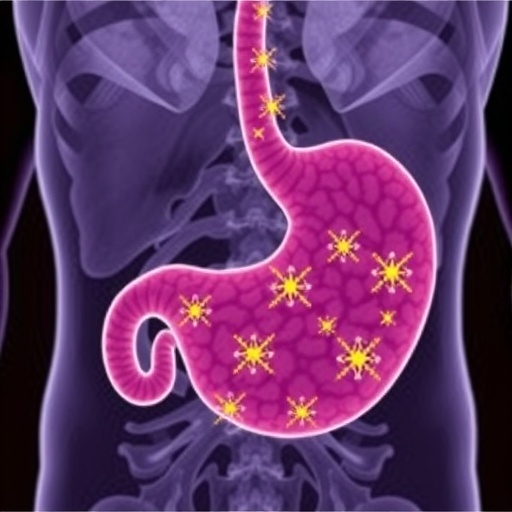In a groundbreaking advance that deepens our understanding of gastric cancer’s molecular underpinnings, recent research illuminates the complex role of circular RNAs (circRNAs) in tumor progression. Gastric cancer, notorious as the fourth leading cause of cancer mortality globally and ranking fifth in incidence, remains a formidable challenge in oncology. While conventional markers and therapeutic targets have yielded limited success, attention has notably shifted toward non-coding RNAs, especially circRNAs, which exhibit remarkable regulatory functions in cancer biology. The study at hand unveils the dualistic behavior of a specific circRNA, circMORC1, bridging its paradoxical expression patterns and functional impact on gastric cancer cells, with potential revolutionary implications for diagnosis and therapy.
Circular RNAs, distinct from linear RNA molecules, form covalently closed loop structures without 5’ to 3’ polarity, conferring them notable stability and unique biological functions. Their capacity to act as molecular sponges for microRNAs (miRNAs) positions them as critical regulators of gene expression, influencing a broad spectrum of cellular processes including proliferation, differentiation, and apoptosis. Researchers have increasingly recognized circRNAs as pivotal modulators of tumorigenesis across multiple cancer types; however, their precise roles in gastric cancer remain insufficiently characterized. This latest investigation offers the first comprehensive genome-wide insight into the alteration of circRNA landscapes within extracellular vesicles (EVs) circulating in patient plasma.
Utilizing state-of-the-art high-throughput RNA sequencing of plasma-derived extracellular vesicles from gastric cancer patients, the researchers identified a marked downregulation of circMORC1. Extracellular vesicles, nanoscale membranous structures secreted into the bloodstream, serve as intercellular messengers carrying nucleic acids and proteins, thereby influencing tumor microenvironment remodeling and systemic disease progression. The decreased abundance of circMORC1 in plasma EVs was paradoxical given its observed upregulation within malignant gastric epithelial cells, underscoring a complex compartmentalized expression pattern reflective of dynamic tumor-host interactions.
To resolve this apparent contradiction, functional characterization of circMORC1 was undertaken using cultured gastric cancer cell lines AGS and SGC-7901. Manipulation of circMORC1 levels revealed a robust promotion of tumorigenic phenotypes: increased cell proliferation, enhanced viability, accelerated migration, and significant inhibition of programmed cell death pathways. These phenotypic effects firmly establish circMORC1 as an oncogenic effector at the cellular level, suggesting its elevated intracellular presence actively drives malignancy progression.
Delving into the mechanistic basis of circMORC1’s oncogenic function, the study employed luciferase reporter and RNA pull-down assays to identify direct molecular interactions. A critical finding emerged demonstrating that circMORC1 binds and sequesters miR-103a-1-5p, a microRNA that ordinarily exerts tumor-suppressive effects by negatively regulating downstream signaling pathways. This interaction exemplifies the “sponge” model, where circRNAs attenuate miRNA availability, thereby modulating post-transcriptional gene silencing. Such a relationship corroborates the emerging paradigm where competing endogenous RNAs (ceRNAs) orchestrate complex gene expression networks in cancer.
Further transcriptomic profiling via RNA-sequencing and quantitative PCR assays implicated the Wnt signaling pathway as the principal downstream effector modulated by the circMORC1/miR-103a-1-5p axis. The Wnt pathway, a well-established driver of cellular proliferation, survival, and metastasis across multiple carcinomas, was found to be relieved from miRNA-mediated inhibition through circMORC1 sequestration of miR-103a-1-5p. This derepression catalyzes aberrant Wnt pathway activation, reinforcing oncogenic signaling cascades that facilitate gastric tumor growth and invasive potential.
Critically, this work delineates a novel regulatory feedback loop wherein circMORC1 acts as an oncogenic RNA sponge to counteract the suppressive effects of miR-103a-1-5p on the Wnt pathway, thereby stimulating tumorigenesis. This mechanistic insight not only enriches current models of gastric cancer molecular biology but also highlights circMORC1 as a compelling biomarker. Its differential abundance in circulatory EVs versus tumor cells offers a dual-faceted diagnostic angle—potentially improving early detection accuracy and monitoring disease progression or therapeutic response.
The clinical implications of these findings are profound. Given gastric cancer’s often late diagnosis and suboptimal prognoses, identifying stable, sensitive biomarkers in plasma EVs introduces a minimally invasive avenue for screening high-risk populations. Moreover, targeting the circMORC1/miR-103a-1-5p/Wnt signaling nexus opens new therapeutic strategies tailored to disrupt the oncogenic RNA interactome. Pharmacological approaches could involve diminishing circMORC1 expression or restoring miR-103a-1-5p functionality, thus reinstating tumor-suppressive pathways and curtailing malignant phenotypes.
This study is emblematic of a broader shift in cancer research emphasizing the non-coding genome’s regulatory capacity. While protein-coding genes have dominated therapeutic targeting historically, the emerging appreciation of circRNAs heralds a future where RNA-based diagnostics and interventions become integral to oncology practice. The stability of circRNAs in biofluids, coupled with their specificity and functional versatility, underscores their translational potential far beyond gastric cancer.
In addition, the compartmentalized expression pattern observed—circMORC1’s increase inside gastric cancer cells but decrease in circulating EVs—raises compelling biological questions regarding nucleic acid trafficking and intercellular communication. The selective packaging or clearance of circRNAs via EVs might constitute a tumor cell mechanism to modulate local versus systemic environments, possibly influencing immune evasion or metastatic niche conditioning. Further exploration of these dynamics may unravel novel facets of tumor biology and systemic regulation.
Furthermore, this research exemplifies the power of integrative multi-omics techniques combining RNA sequencing, biochemical assays, and functional cellular analyses to decode intricate molecular interplays. Such an approach not only strengthens the validity of discovered mechanisms but also accelerates the translation from molecular findings to clinical application, underscoring the vital role of interdisciplinary collaboration within biomedical sciences.
In conclusion, the revelation of circMORC1’s oncogenic role through miR-103a-1-5p sponging and subsequent Wnt pathway activation represents a significant leap forward in gastric cancer research. By defining a previously unappreciated RNA-based regulatory axis, this work opens novel avenues for biomarker development and targeted therapeutics. As research continues to unravel the expansive regulatory universe of circRNAs, their integration into precision oncology frameworks promises to transform gastric cancer management and improve patient outcomes worldwide.
Subject of Research: Regulation of gastric cancer progression by circMORC1 via miR-103a-1-5p sponging and Wnt signaling pathway modulation.
Article Title: CircMORC1 downregulated in plasma EVs promotes gastric cancer cell proliferation and invasion via miR-103a-1-5p sponging.
Article References:
Zhai, XM., Yang, YQ., Lin, L. et al. CircMORC1 downregulated in plasma EVs promotes gastric cancer cell proliferation and invasion via miR-103a-1-5p sponging. BMC Cancer 25, 1313 (2025). https://doi.org/10.1186/s12885-025-14688-7
Image Credits: Scienmag.com




